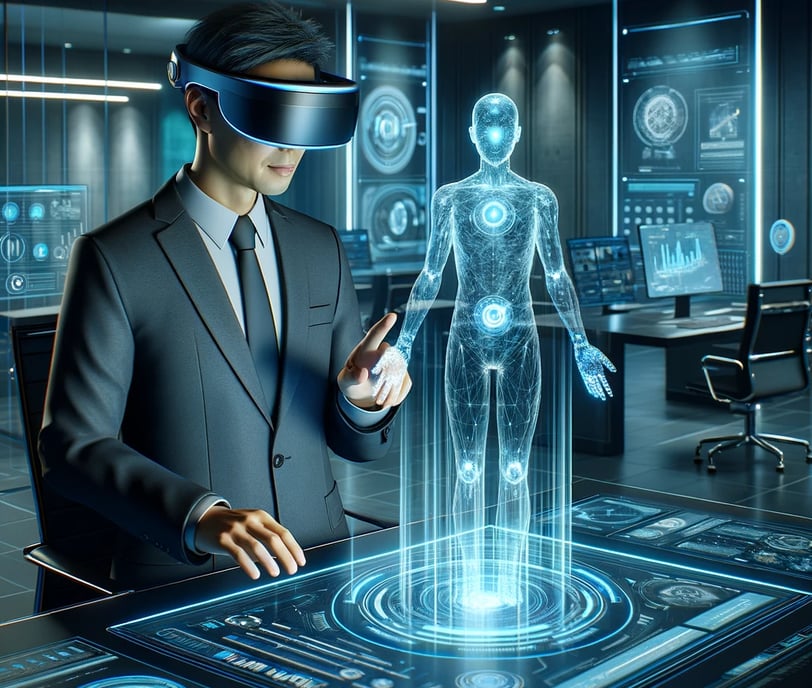The Intersection of VR, AR, Blockchain, and AI
How blockchain, virtual reality, augmented reality and Artificial Intelligence sets the stage for something more.
GAMINGARTIFICIAL INTELLIGENCEBLOCKCHAIN
SOL Spark
4/27/20244 min read


In the digital age, virtual reality (VR) and augmented reality (AR) are rapidly transforming how we interact with the world around us. These technologies are being enhanced by blockchain, providing a robust framework for secure transactions and digital ownership. This blog explores how blockchain, coupled with artificial intelligence (AI), is not just capitalizing on VR and AR but is also pushing these technologies towards new frontiers.
The Current State of VR and AR
Virtual and augmented realities have made significant strides in recent years. Technologically, VR and AR devices have become more sophisticated and accessible, offering more immersive and interactive experiences. From gaming to medical training, these technologies are making a mark across various sectors. Statistically, the VR and AR markets are expected to grow exponentially, with forecasts suggesting a multi-billion dollar industry in the next few years.
A few examples of some promising projects:
Virtex Stadium: This startup is revolutionizing the way fans experience sports by integrating AR and VR into live events, enhancing the immersion and interaction of spectators with real-time gameplay in a virtual stadium environment.
Labster: Focused on Education, Labster provides VR simulations that allow students to conduct scientific experiments in a virtual lab setting. This platform is particularly beneficial for educational institutions lacking the physical resources for comprehensive science.
Dispelix: An innovative company creating ultra-thin, waveguide displays for AR devices. Their technology enhances the quality and power efficiency of displays used in AR glasses, making digital content more seamlessly integrated with the real world
VR and AR are set to have monumental leaps in the years to come, with these technologies becoming more mainstream and included into day to day living and usage.
Blockchain as a Game Changer in VR
Blockchain technology is revolutionizing the VR and AR spaces by introducing secure digital ownership and new monetization strategies. Platforms like Decentraland and Somnium Space use blockchain to manage virtual real estate transactions and create economies within their digital worlds, where users can buy, sell, and trade assets as non-fungible tokens (NFTs) (Decentraland, Somnium Space).
As it has been discussed in previous posts, the advent of blockchain gaming opens up the door to a new way to digital ownership and claiming a stake of a gaming ecosystem through interaction and diving into the game worlds that reside within. VR and AR would not only supplement this, but it will also be more instrumental as the gaming world evolves. Products ranging from Playstation VR, Meta Quest and Apple Vision to the Omni One and the Virtualizer ELITE 2 are merely the first step towards utilizing on chain assets in virutal worlds that lean towards more interactive, minecraft style platforms while also giving a more realistic feel to games as a whole.
VR that utilizes the whole body instead of just sitting with a controller would have an allure, as a gamer with a greater physique would find such a product appealing.
The Convergence of AI with VR and AR
AI is set to enhance VR and AR technologies by making environments more interactive and responsive. AI can improve image recognition, personalize experiences, and even predict user behavior to create more engaging content. For example, AI-driven analytics can help in tailoring virtual events or shopping experiences to individual preferences, enhancing user engagement.
Such projects that are leading the charge in this endeavor:
Stanford's Neural Holography: Researchers at Stanford have developed neural holography techniques using AI to improve the quality of holographic displays. This involves using neural networks to simulate the physics of light more accurately, which can greatly enhance the realism of VR and AR visuals (Stanford News).
DeepFovea by Meta: This project employs AI for foveated rendering, a technique that significantly reduces the computational load for rendering VR and AR images. By focusing high-quality rendering only where the user is looking and using AI to fill in peripheral vision with less detail, DeepFovea allows for more efficient and high-quality visual experiences (Meta AI).
Yu-Gi-Oh! MASTER DUEL x AI Project by Konami: This initiative integrates AI into the Yu-Gi-Oh! digital card game, enabling AI-driven duels that learn and adapt over time. The project showcases AI's potential to enhance gaming experiences by providing a more dynamic and challenging opponent that evolves as it learns from each duel (Yugioh).
Utilizing AI with VR and AR would open the door to a variety of different applications that would serve well within various industries, while also providing every day people the capability of working from home utilizing such technology, which in turn would make remote jobs more appealing instead of having to come into the office every day. Combine this with holographic technology and you'd be capable of projecting yourself into the office, and interacting at the office remotely with said VR technology.
AI assistance would aid with keeping everything in real time and potentially reduce latency when projected from a remote location. As Meta has stated about DeepFovea, the efficiency of ease with high quality rendering would make this reality more apparent.
Gaming with these aspects could lead to a new line of games and gaming products that would challenge our current understanding of video games, and how lifelike and interactive that they can truly become. Combine this with a blockchain foundation, and it could be a recipe for an incredible level of innovation.
The synergistic combination of VR, AR, blockchain, and AI is forging a path to a future where digital and physical realities are seamlessly integrated. As these technologies continue to evolve, they promise to redefine our digital interactions and expand the horizons of what is possible in virtual spaces.
A gifted human player could always triumph over the game’s AI because the software couldn’t improvise.
